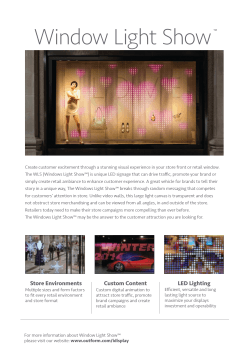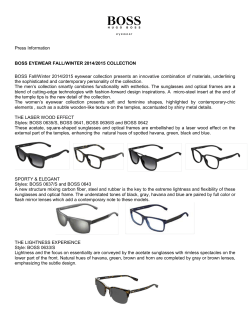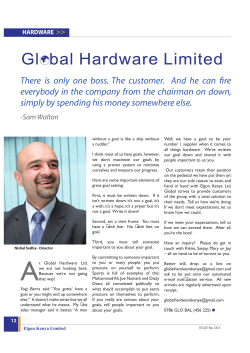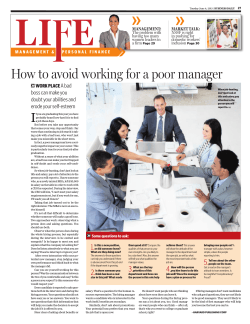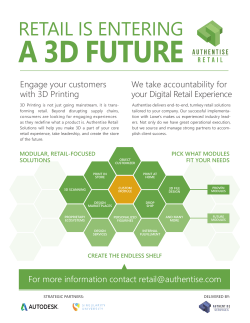
Annual Shareholders` Meeting 2015 â Speech Claus
Annual Shareholders' Meeting 2015 – Speech Claus-Dietrich Lahrs (CEO) Stuttgart, May 12, 2015 - The spoken word shall prevail Good morning, Ladies and Gentlemen. On behalf of my fellow members of the Managing Board, I would like to wish you all a warm welcome to this year's Annual Shareholders' Meeting of HUGO BOSS AG, here at the Messe Stuttgart. I would also like to welcome all those who are following this event via our online stream. I would like to begin by looking back over 2014. By doing so, I will explain the most important operational as well as financial developments of the past 12 months. Allow me then to present the key features of our growth strategy, which we have further developed. Finally, I would like to give you a brief outlook for the current fiscal year and the results for the first quarter. But first we will focus on the past fiscal year. HUGO BOSS generated solid sales and earnings growth in 2014. Group sales rose by 6%, adjusted for currency effects. Adjusted operating profit was up 5% on the previous year. That means: 2014 was the fifth year in succession that we were able to improve both sales and earnings. Since 2009 we have grown consolidated sales by one billion euros and more than doubled operating profit over the same period. Without a doubt, this success is attributable to the outstanding commitment of our employees and their passion for the company. Consequently, I would like to express my thanks to all those working for HUGO BOSS throughout the world. Allow me to briefly address the factors that contributed to our good result in 2014. If the past year has demonstrated one thing, it is the value of a globally balanced market presence, for every region has made its contribution to the growth in consolidated sales. Nonetheless, HUGO BOSS generates a significant share of its business in markets that are more mature and economically less volatile. Our largescale business in Europe in particular shielded us from the economic turmoil in various emerging markets and from the dramatic exchange rate fluctuations to which many competitors were exposed. Europe is, of course, by no means an easy market and is also one that continues to be characterized by wide regional disparities and political uncertainty in individual countries. However, thanks to the rapid transformation of our business model and our traditional strengths in the wholesale business, our results more than bucked the overall trend in our industry. With a 16% increase in currency-adjusted terms, Great Britain was once again the fastest-growing core market in the region. In Germany as well, HUGO BOSS grew by 7%, in line with the overall region. 13.05.2015 1/9 The Americas did not achieve the excellent result we had grown accustomed to in recent years. Nevertheless, sales rose by 4% and we could realize important operative improvements. The US market, which accounts for the majority of our business in the region, also saw growth of 4%. In Asia, finally, market share gains and the robust expansion in the region's smaller markets led to solid growth of 7%. However, we too were unable to wholly escape the effects of a further slowing of economic growth in China and increasing purchasing restraint in the luxury segment, meaning that the region contributed growth of only 2%. Oceania and Japan, on the other hand, finished the year much stronger. In terms of distribution channels, sales in the Group's own retail business rose by 12% over the year as a whole. All retail formats showed double-digit growth. This came from new openings and takeovers as well as comp store sales growth of 3%. In wholesale, by contrast, there was a slight decline in sales. This was chiefly a consequence of takeovers, which necessitate a shift in sales from wholesale to our own retail business. Further consolidation within the industry also played a role. However, there was solid growth in our core business with department stores. Lastly, in royalties we posted stable sales development on the previous year. As a result of the expansion and due to the improvement in sales productivity, the share of our own retail business in Group sales climbed to 57% in 2014. Our performance over the past five years provides impressive evidence of the transformation of our business model. We strive to further increase the retail share in the years ahead to generate more than three quarters of Group sales in this distribution channel by the year 2020. In 2014 we continued to expand the global network of directly operated stores and shops. We opened 66 new stores and took over 20 more. The number of our own retail stores thus increased by 31 locations net, after taking account of closures. In addition to new openings, we are increasingly making use of renovations to extend the existing retail space. For example, in 2014 we took over adjacent retail outlets to expand our stores in Berlin on the Kurfürstendamm, in Zurich on Bahnhofstraße and in London on New Bond Street. Overall, we have increased the retail space of our own retail network by 5,000 to a total of 140,000 square meters in the year 2014. The highlights of the new openings in 2014 included our new flagship store in Osaka, Japan, which undoubtedly sets architectural standards, as well as our second flagship store in Hong Kong on Canton Road, which already opened its doors in January 2014 in this important Asian metropolis. Our own stores offer an excellent platform for displaying our collections to great effect. In this way, we reach consumers with whom we do not otherwise come into contact in the traditional wholesale business. This applies particularly to our offering in the luxury segment. 13.05.2015 2/9 A visit to any of our stores shows why 2014 was an especially successful year for BOSS Womenswear. One-and-a-half years after his appointment as Artistic Director at HUGO BOSS, Jason Wu has fundamentally changed the perception of the brand in this segment, one that is so important for us. In his collections, Jason Wu has combined the tailoring for which our menswear is known with a modern, feminine elegance. In terms of presentation, we are adapting to the needs of our female customers – from labeling through furnishing concepts to store design. This is accompanied by attractive communication and unusual events. For example, our campaigns and shows at the New York Fashion Week make it clear that we have reached a new level in women's fashion. Thus it comes as little surprise that a double-digit rise in sales was recorded for womenswear, both in wholesale and our own retail business, as well as in all three regions. An increase of as much as 18% was recorded for the BOSS core brand. Strong growth in tailoring and in shoes and accessories were key factors here. In the fragrance segment too, women's fragrances now account for about one third of our business. Last year's successful launch of BOSS MA VIE contributed to this result. It was not only in womenswear, but in menswear too that 2014 was a year in which we made great strides in further strengthening our brand. In Germany, HUGO BOSS was recognized as the "Best fashion brand" in the best brand rankings. In China, we topped the "Hurun Best of the Best" ranking, the most important consumer-survey based ranking in the Chinese luxury market. We had already been among the top five for some years, and in 2015 were ranked as the "Best fashion label for men" for the first time. However, we have also been working to strengthen our operational processes in order to better meet the higher challenges posed by global purchasers. Without any start-up difficulties, we have put our new state-of-the-art flat-packed goods distribution center in Filderstadt, located just a few kilometers from here, into operation in the middle of 2014. Since then, we have been benefiting from greater speed and flexibility in delivery and from improved efficiency in logistics processes. All these developments and milestones spurred the growth of the Hugo BOSS Group in the past fiscal year. Almost EUR 2.6 billion sets a new record for sales. The gross profit margin also improved significantly by 120 basis points to 66.1%. This was mainly attributable to above-average growth in the Group's own retail business, whose gross profit margin is higher than that of wholesale. This improvement continued to be partly the result of granting fewer discounts. While operating profit adjusted for special items was up 5%, higher operating expenses led to a slight decrease of 20 basis points in the adjusted EBITDA margin to 23%. This effect can be explained chiefly by a higher increase in distribution and marketing expenses. On the one hand, this can be attributed to the expansion of our store network and higher rents. On the other hand, we have increased our marketing expenses by roughly EUR 25 million. Taking into account special items of EUR 19 million and the higher depreciation and amortization expense, Group EBIT fell by 2%. However, as a result of the greatly 13.05.2015 3/9 improved net financial result in the wake of debt reduction and the lower interest rate, at EUR 334 million net income was stable. Allow me now to present the balance sheet and cash flow development in a little more detail. In line with our forecast, capital expenditures fell in comparison to the prior year and came to EUR 135 million in the reporting period. The decrease was largely attributable to the absence of expenses in connection with the construction of the flat-packed goods distribution center. Capital spending in our own retail business was also down. Lower expenses for new projects after the numerous openings of flagship stores in 2013 are the reason for this. By contrast, expenditure on renovation and now make up almost half our total investment budget for retail activities. Together with the rise in profits, the decrease in capital expenditures contributed to a robust increase in free cash flow. As a consequence of this, net financial liabilities fell to EUR 36 million at year's end. This year's dividend proposal confirms our strategy to pay 60% to 80% of consolidated net income to the shareholders. The proposed dividend of EUR 3.62 per share is 8% above the prior year level and equivalent to an increase in the payout ratio to 75%. This proposal takes into account the earnings development in 2014, including the non-cash special items that I mentioned earlier, as well as the overall strong financial situation of our company and our expectations for 2015. For the current year, we expect that the continued improvement in our earnings and disciplined management of the trade net working capital will result in a strong free cash flow development. Ladies and gentlemen, in addition to the dividend payments the increase of the share price also offers you a way to participate in the success of the Company. In the past years, HUGO BOSS has clearly outperformed the development of the market. Since the year 2009, our share has gained more than 400%. The past year, however, was characterized by rather sideways movements, similar to the development of the overall market, with harsh temporary variation. The shares of the listed apparel and luxury companies finished the year with a below average performance. With a decrease of 2% over the year 2014, HUGO BOSS outperformed the relevant competitors but fell short of the slight gains realized by the overall market. I would now like to have a look at our corporate strategy in more detail, as it is intended to secure the profitable growth of the HUGO BOSS Group. Our 2020 growth plan very much builds on two elements that have proven their worth since their introduction in 2008. The first of these is our own retail business to which we attach great importance both from a strategic and financial perspective. The second is further internationalization, in which we also continue to see great potential. Although these two cornerstones retain their value today, we have further developed our strategy and adapted it to the changes occurring around us. The growth strategy is based on four pillars, whose successful implementation is ensured by the continuous optimization of our operational processes. 13.05.2015 4/9 Allow me to briefly present these four pillars. First, we have begun to elevate the Boss core brand so that we can meet the challenges posed by an increasingly demanding, global consumer. Second, we are expanding our womenswear business in order to meet the needs of the modern woman, at work and in her free time. Third, we are driving forward the expansion of omnichannel services in response to changing consumer habits, to promote growth in our own retail business online and offline. And the fourth pillar: we will go on investing in markets in which, until now, our presence has been weak. Let's now look more closely at the different pillars of our strategy. In 2015 we will be building on the progress that we have achieved by elevating the BOSS core brand. We are convinced that, with offerings from the premium segment, and increasingly also from the luxury segment, we can today satisfy a broader range of customers. We are therefore in the process of clearly differentiating our brand portfolio by market segment and distribution channel. Even more importantly: We are elevating BOSS by exploiting the potential of the brand above the premium segment as well. We assume that in 2015 we will make good progress in this regard. Accordingly, the shares in sales of our "BOSS Tailored" and "Made to Measure" luxury collections will grow this year and beyond. This development is being driven in particular by our own retail business, where the luxury is already far greater than in the wholesale business. In the future, the distribution of our BOSS core brand will thus be focused almost exclusively on monobrand stores and shops. This holds true of our own retail business, where a growing number of freestanding stores will in the future only offer BOSS. In wholesale too, we will exert greater control over the brand image by working with our partners to only distribute BOSS in shop-in-shops. These may be operated by our retail partners or directly by ourselves. In the category business, i.e. on multi-brand retail spaces, we will be offering our partners HUGO in the apparel segment and BOSS Green in the sportswear segment, but no longer the BOSS core brand. This transformation process has just begun. In the completed buying season for the 2015 autumn collection, we have for the first time extended the concept to a larger group of customers. As we had already involved them closely in the development process for the collection, the new HUGO offering was warmly received. Additionally, we have secured the implementation of about 100 more shop-in-shops at different major customers in Germany and in neighboring countries. This high number is similar to last year. In this early phase, we have consciously decided on an overlap between the BOSS and HUGO collections at entry-level prices, so that we can ensure a smooth transition. In the coming seasons, we will also elevate the BOSS offering in terms of price. As the US is the only other major market, apart from Germany, with a significant category business, we will also be extending this concept to the United States. Let's now turn to the second pillar of our strategy, namely womenswear. The unmistakable design signature of Jason Wu, impressive shows and the enormous response from the media significantly boosted the profile of BOSS Womenswear over the past year. 13.05.2015 5/9 In 2015 we will be placing greater emphasis on the unique feminine aesthetic that Jason Wu introduced with his first collection. We are combining the tradition of our brand in men's tailoring with femininity and subtle details. We are therefore confident that BOSS will be the brand of choice for the modern woman of the 21st century. Accessories are becoming ever more important in the honing of this brand profile. The market launch of our new BOSS Bespoke Bag is a clear acknowledgment of this. With perfectly fitting cuff links, borrowed from men's fashion, as clasps, it echoes the roots of the brand in this area. Like most of our bags, the BOSS Bespoke is manufactured in Italy. With a retail price of approximately EUR 1,000 in most European markets, the launch clearly articulates our aspirations in this segment. Beyond the collections, BOSS Womenswear will be a key focus of our brand communication. As we did last year, we are planning to devote about half the communication budget to this segment. And for our next appearance at New York Fashion Week, already scheduled for September, Womenswear will be at the heart of our show. We believe that this will further boost the desirability of our brand. Bearing all this in mind, we are confident that there will again be double-digit growth in sales of BOSS Womenswear in 2015. Ladies and gentlemen, as a company we must respond to the continuously changing shopping behavior of our customers. Influenced by the increasing digitalization of nearly all areas of life, today’s consumers do not distinguish between online and offline experiences as they used to do in the past. Instead, the term “noline” is well suited to describe especially young consumers’ preferences as they tend to move seamlessly between the two worlds. They seek shopping inspiration from a range of different sources. Prior to a purchase decision, extensive online and offline research is done. Interestingly, however, buying in physical stores remains the preferred way of shopping. In this development, we have identified an enormous opportunity. Consequently, we seek to liaise our online and offline presence in an optimal way. Due to such an omnichannel approach, we will increase the attractiveness for our customers as they will be able to experience our brands consistently across all touchpoints. To this end we have already significantly upgraded our online offering in 2014.. First, we took over the online store front end and created an architecture that meets the most exacting requirements. This has contributed to visibly improving the look and feel of the website. Then we upgraded the online and mobile portals of our internet presence hugoboss.com. This was done in order to bring together what were previously separate ways of accessing the e-commerce area and the brand website. The seamless integration of content and commerce, in other words of editorial content and ecommerce offerings, and the systematic performance orientation of our digital marketing activities means that we are getting better and better at attracting visitors to our website and turning them into customers. In the year 2015, we will continuously introduce new functionalities and services on hugoboss.com. 13.05.2015 6/9 In the year 2016, we will then launch important omnichannel services like “click and collect”, the pick-up of products ordered online in our stores. Maintaining the tight control over all elements of the online value chain is essential in this regard. However, today a wide range of online activities is still managed by an external service provider. In the next year, we will change this and take mainly the logistics in-house. For this reason, HUGO BOSS is currently converting the former flat-packed goods distribution center in Wendlingen into a modern business-to-consumer distribution center. This will not only handle deliveries to end consumers, but also the entire return processing for the European market. Start-up is planned for the beginning of the coming year. Finally, let’s turn to the fourth pillar of our growth strategy: the opportunities that are arising for us throughout the world. Allow me therefore to discuss the three regions briefly: I have already said that we were extremely satisfied with the performance of our Europe business, despite the deceleration in growth toward the end of last year. We are confident that we will outperform the market as a whole in 2015, too. Nonetheless, the underlying conditions at the start of this year remain difficult. This applies to almost all regional markets. In Germany, for example, industry studies indicate that textile retailing has been declining for seven consecutive months. This is in contrast to a generally favorable consumer confidence. In other important markets such as France or the Benelux countries, we are observing a similar development. In an environment in which decreasing customer footfall has become the main challenge for the sector, we have to redouble our efforts to make our stores even more attractive to customers. This is why we are focusing on a consistent, high-quality brand experience. This is why we are investing in service and customer relationship management. This is why we are taking advantage of our opportunities in womenswear and conquering new markets such as the Middle East, where we will be managing our business ourselves from 2016 on. In the Americas we are cautiously optimistic that we will be able to improve our performance in 2015. However, this confidence is based more on the opportunities we have identified specifically for our business than on expectations of a general upturn in the market. On the contrary, we expect the market environment in the department stores to remain characterized by heaving discounting, since it seems that the apparel industry can benefit only very little from the positive general economic situation. The key to profitable growth is therefore to expand our market control. In our own stores, we will be focusing on further improving our retail management. The new management team headed up by Gerrit Rützel, who was previously responsible at HUGO BOSS for the Asia-Pacific region and took over the Americas region at the start of the year, has already initiated numerous system and process-related improvement measures, many of which have already proven their worth in Europe. We expect these initiatives to boost the sales momentum in our own retail business in the future. We will also drive forward the performance of our important license business at Saks by optimizing shop layouts, ranges and merchandise flows. 13.05.2015 7/9 In the US wholesale business, we are in intensive talks with our partners with a view to optimizing the consistency of our brand image. In the short term, this means that we are systematically placing the focus on increasing the share of sales at full price. In the medium to long-term, we are very interested in taking over control of how the point of sale is designed for our BOSS core brand at major customers. In the Asia-Pacific region, we expect the heterogeneous development of the market as a whole to continue. While we anticipate difficult conditions to persist in China, we assume that the environment will be more favorable in the rest of Asia. Despite the challenging market conditions in China, we achieved a respectable performance last year. Our systematic orientation toward men's tailoring, both in merchandising and in our brand communication, have absolutely paid off. Nevertheless, we continue to be challenged by declining store traffic. This reflects the slowdown of economic growth, including the pressures on the local real estate market, on the one hand, and the lower social acceptance of premium and luxury goods on the other hand. Both factors are expected to persist for the foreseeable future. Outside China, we expect another good year in Australia and Japan. In the latter, we significantly upgraded our distribution in 2014. The opening of our flagship store in Osaka at the same time as the closure of eleven shop-in-shops across the country is an expression of our endeavors to strengthen perception of the brand and increase our profitability. Furthermore, we have just taken over direct control of the business in South Korea, a market whose importance has grown dramatically in recent years. Ladies and gentlemen, we benefit from our operating strength wherever in the world our Company is active. Our ability to develop, produce and deliver high-quality products in large numbers efficiently, quickly and on an industrial scale gives us a decisive competitive advantage. We are further strengthening this advantage by aligning our business model even more consistently to the requirements of our own retail business. In addition to rolling out new IT systems to plan the inventory requirements of our own stores, we are focusing on the consolidation of our own production activities in 2015. We have decided to sell our production facility in Cleveland, United States, in order to concentrate our activities at a smaller number of larger plants. Our most important own production facility in Izmir, Turkey, will therefore be of even greater importance in the future, as is reflected in the ongoing expansion activities at the plant. On the other hand, we have been able to successfully sell the Cleveland facility to another clothing producer without any loss of jobs. Accordingly, this transaction will generate a non-recurring profit in the mid-single millions for us in the second quarter. Ladies and Gentlemen, let us now turn to the outlook for the current fiscal year. All the strategic initiatives that I have just described will contribute to making 2015 a year of solid sales and earnings growth. For Group sales we are expecting growth in the mid-single digit percentage range on a currency-adjusted basis. Thanks to the positive effects of currency translation, the increase will be higher when denominated in euros. Retail sales growth will exceed 13.05.2015 8/9 overall Group sales growth. By contrast, in the wholesale business we anticipate a decrease. Adjusted EBITDA will likely rise by 5% to 7%. An increase in the gross profit margin will support this development. However, as a result of expanding the retail business, we will see an increase in distribution expenses. Once again, we will also be spending more on marketing. Currency fluctuations will only have an immaterial positive effect on the development of the operating result. Finally, capital expenditure in 2015 will come to between EUR 200 million and EUR 250 million. The majority of this will again be accounted for by our own retail business. In addition to the opening of 50 new stores and further takeovers, renovations will play an important part in this. The results for the first quarter, which were published only last week, confirm to us that the overall expectations for 2015 are correct. The difficult market conditions, which had already emerged toward the end of the last fiscal year, also characterized the first three months of this year. Against this backdrop HUGO BOSS has achieved a solid performance. Group sales of EUR 668 million were up 9% over the comparable prior-year period. Adjusted for currency effects, the increase in sales reached 3%. This positive development was again mainly driven by growth in the Group's own retail business, where comparable store sales have accelerated since the end of the year 2014. BOSS Womenswear and our online business, as outlined two focus areas of our growth strategy, achieved doubledigit growth rates. The operating result before depreciation, amortization and special items was stable in comparison to the prior-year period and totaled EUR 132 million. An increase of the gross margin was partly compensated by higher operative expenses. Allow me to summarize what I have said. In 2014 we successfully mastered the difficult market conditions and achieved a satisfactory result overall. We made good progress in all the initiatives that I have just described. However, we are also aware that a great deal of work lies ahead of us: developing our market position in the luxury segment, expanding the womenswear business, transforming retail into an omnichannel experience, accelerating growth primarily in the Americas and China, and strengthening our operational processes. All these are central. These challenges motivate the Managing Board as well as all HUGO BOSS employees. Together and with great passion, we will work hard in 2015 to further build the success of the Company that is yours, dear shareholders. In doing so, we will tap the full potential of this fascinating brand. Thank you very much for your attention. 13.05.2015 9/9
© Copyright 2025

